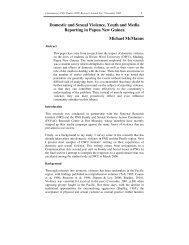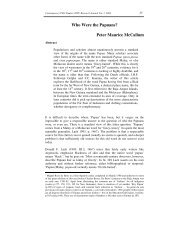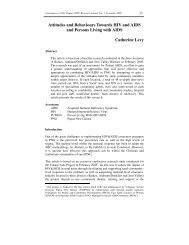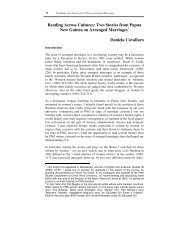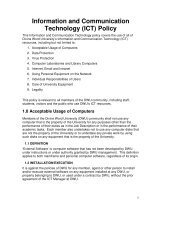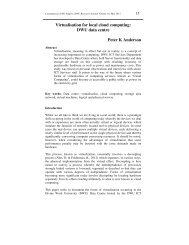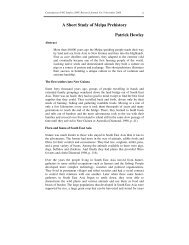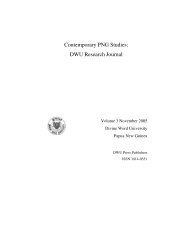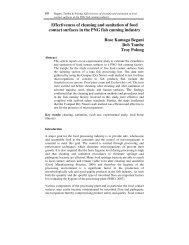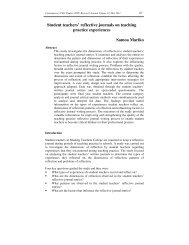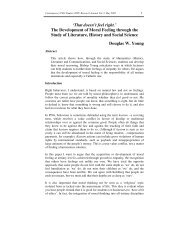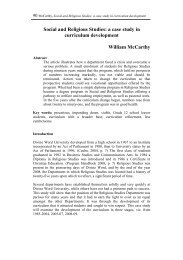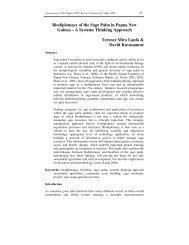Outcomes-Based Education - Divine Word University
Outcomes-Based Education - Divine Word University
Outcomes-Based Education - Divine Word University
Create successful ePaper yourself
Turn your PDF publications into a flip-book with our unique Google optimized e-Paper software.
Contemporary PNG Studies: DWU Research Journal Vol. 5 November 2006 45<br />
<strong>Outcomes</strong>-<strong>Based</strong> <strong>Education</strong>: A PNG Perspective<br />
Pam Norman<br />
Abstract<br />
This article explores the underpinning principles of outcomes based<br />
education (OBE) and aims to dispel some of the confusion and lack of<br />
understanding that surrounds it. The article draws upon the work of<br />
William Spady (1994, 1998) who is regarded as an authority in this field.<br />
Four essential principles of OBE are clarity of focus, designing back,<br />
high expectations and expanded opportunities, which are underpinned by<br />
the understanding that all students can learn and succeed but not all in the<br />
same time or in the same way; successful learning promotes even more<br />
successful learning; and schools (and teachers) control the conditions that<br />
determine whether or not students are successful in school learning.<br />
While outcomes can be written for traditional, transitional or<br />
transformational goals, it is the transformational approach that has been<br />
adopted by the current curriculum reforms in Papua New Guinea. This<br />
provides the opportunity for greater accountability for the outcomes of<br />
education to prepare students to be competent future citizens<br />
Introduction<br />
Although awareness is growing about the outcomes based reform curriculum<br />
that has been developed in Papua New Guinea, it is surprising how little<br />
understanding teachers have of the underpinning principles of the approach and<br />
its benefits for learners. While recognising that there are critics as well as<br />
advocates, this article explores characteristics of outcomes-based education<br />
(OBE) and relates them to the current curriculum reforms. At this early stage of<br />
OBE implementation in Papua New Guinea, the need is for educators to<br />
understand the basic principles of an outcomes based approach and why<br />
teachers from elementary to grade twelve, and increasingly in other levels of<br />
the education system, are being challenged to adopt it as their practice. The<br />
article is intended to raise awareness of the principles and application of OBE<br />
to planning, teaching and assessment of student learning. This paper supports<br />
the notion that teaching practices should be guided by what we want students to<br />
learn and what we want them to be able to do as a result of their education and<br />
training.<br />
What is outcomes based education<br />
<strong>Outcomes</strong> based education focuses on what students can actually do after a<br />
learning experience. While many educators have contributed to the discussion<br />
on outcomes-based education, William Spady (1994, 1998) is widely regarded<br />
as OBE’s leading advocate. Spady (1994:1) and his ideas have had a significant<br />
impact on the approach adopted in Papua New Guinea and in other countries.<br />
He explains outcomes based education as follows:
46 Norman, <strong>Outcomes</strong> <strong>Based</strong> <strong>Education</strong>: A PNG Perspective<br />
<strong>Outcomes</strong> <strong>Based</strong> <strong>Education</strong> means clearly focusing and organising<br />
everything in the education system around what is essential for all<br />
students to be able to do successfully at the end of their learning<br />
experiences. This means starting with a clear picture of what is important<br />
for students to be able to do, then organising the curriculum, instruction<br />
and assessment to make sure that learning ultimately happens (Spady<br />
1994:1).<br />
The validity of the approach assumes that the officers of the Curriculum<br />
Development Division in consultation with community stakeholders can<br />
determine what things are ‘essential for all students to be able to do’ to be<br />
effective citizens, and that it is possible to achieve these things through<br />
appropriate classroom practices.<br />
By making explicit what we want students to know and be able to do – the<br />
outcomes of their learning – OBE provides a clear picture of the knowledge,<br />
skills and values to be gained and demonstrated as students progress through a<br />
program. OBE is concerned with clear statements of the outcomes of an<br />
educational program that curriculum developers consider are critical for all<br />
students to be effective citizens in real life situations.<br />
The definition of ‘outcomes’ is important to understand this approach to<br />
education. Spady and Marshall (1994:20) wrote:<br />
<strong>Outcomes</strong> are ‘clear, observable demonstrations of student learning that<br />
occur after a significant set of learning experiences. They are not values,<br />
attitudes, feelings, beliefs, activities, assignments, goals, scores or<br />
averages, as many people believe. Typically these demonstrations reflect<br />
three things:<br />
What the student knows<br />
<br />
<br />
What the student can actually do with what he or she knows<br />
The student’s confidence and motivation in carrying out the<br />
demonstration.<br />
<strong>Education</strong> that is outcome-based is learner centred, results oriented and<br />
founded on the belief that all students can learn. James Towers (1996:19) lists<br />
four points that are necessary for an outcomes-based approach.<br />
What the student is to learn must be clearly identified.<br />
The student’s progress must be based on demonstrated achievement.<br />
Multiple instructional and assessment strategies need to be available to<br />
meet the needs of each student.<br />
Adequate time and assistance needs to be provided so that each student can<br />
reach their maximum potential.<br />
Three underpinning premises<br />
<strong>Outcomes</strong> <strong>Based</strong> <strong>Education</strong> is underpinned by three premises:<br />
• All students can learn and succeed but not all in the same time or in the<br />
same way
Contemporary PNG Studies: DWU Research Journal Vol. 5 November 2006 47<br />
• Successful learning promotes even more successful learning<br />
• Schools (and teachers) control the conditions that determine whether or<br />
not students are successful in school learning.<br />
On to these points we can overlay the philosophical base suggested by Albert<br />
Mamary (1991) in his discussion of outcomes-based schools:<br />
All students have talent and it is the job of schools to develop it.<br />
The role of schools is to find ways for students to succeed, rather than<br />
finding ways for students to fail.<br />
Mutual trust drives all good outcomes-based schools.<br />
Excellence is for every child and not just a few.<br />
By preparing students every day for success the next day, the need for<br />
correctives will be reduced.<br />
Students should collaborate in learning rather than compete.<br />
As far as possible, no child should be excluded from any activity in a<br />
school.<br />
A positive attitude is essential. (If you believe that you can get every<br />
student to learn well then they will.)<br />
Four essential principles<br />
Following on from the premises that underpin OBE, Spady developed four<br />
essential principles: clarity of focus, designing back, high expectations and<br />
expanded opportunities. Unless these are present, a person, school or system<br />
cannot be said to be using an outcomes based approach.<br />
Clarity of focus<br />
The first principle, clarity of focus, means that all planned learning must be<br />
clearly focused on what we want students ultimately to be able to do<br />
successfully. Two implications are for outcomes to be clearly expressed in<br />
demonstrable terms and for student assessment to focus on clearly defined<br />
significant outcomes. Students have a better chance of experiencing genuine<br />
success when they clearly understand the goals for which they are striving<br />
(Charles 1999:244). The starting point is the clear definition of learning<br />
outcomes in the syllabus documents and letting students know what they are<br />
aiming for. We start where we want to end up.<br />
Teachers often ask for an explanation about the difference between ‘objectives’<br />
(a concept with which they are familiar) and ‘outcomes’. A useful distinction I<br />
have found is that objectives use future tense and outcomes use present tense.<br />
An objective may state, ‘By the end of a unit students will be able to ‘apply and<br />
use the four operations - add, multiply, divide and subtract- to do calculations<br />
with three and four digit numbers’. As an outcome, it is written as, Students<br />
can …, Students are able to …, or simply Students … ‘apply and use the four<br />
operations - add, multiply, divide and subtract- to do calculations with three<br />
and four digit numbers’. The objective states the ‘intent’ of what the teaching<br />
should lead towards. By comparison the outcome wording is the endpoint.
48 Norman, <strong>Outcomes</strong> <strong>Based</strong> <strong>Education</strong>: A PNG Perspective<br />
<strong>Outcomes</strong> are very learner-focused and clearly indicate the student<br />
performance to be demonstrated.<br />
However, an outcomes based approach to education is far more than simply<br />
rewriting objectives into a present tense form. Killen (2000:3) observes that the<br />
concept is inappropriately used for a variety of educational practices that pay<br />
little more than lip service to the fundamental principles of OBE. A system can<br />
only be said to demonstrate an outcomes based approach when it incorporates<br />
the principles of clarity of focus, designing back, high expectations and<br />
expanded opportunities.<br />
Designing back<br />
The second principle, designing back, means that all planning, teaching and<br />
assessment decisions are made by tracing back to the desired end result.<br />
Consider an outcome such as: Students investigate and implement practical<br />
ways to produce and prepare food for personal consumption or to generate an<br />
income (PNG Department of <strong>Education</strong> Making a Living Syllabus, 2003:12).<br />
From the outcome, the second step is to consider appropriate and relevant<br />
assessment tasks as evidence that the outcome has been achieved. This step so<br />
early in the planning process is a major difference from the traditional<br />
approach where teachers are often very concerned about the content they are to<br />
input before they consider assessment tasks for students.<br />
Possible assessment tasks for the cited outcome could be that students:<br />
Gather information on a range of ways of preparing food for consumption<br />
or sale; survey demand for types of food to be sold<br />
Follow recipes, use different methods and utensils, serve and present food<br />
for different occasions<br />
Market food, estimate costs, calculate selling process and profit, advertise,<br />
package, serve customers, keep records<br />
Produce food, garden, fish, raise livestock.<br />
By looking back at the outcome and then designing the assessment tasks,<br />
teachers then ‘design backwards’ to determine the content and activities needed<br />
to do the tasks. Curriculum relevance is an issue in Papua New Guinea. A<br />
benefit of the OBE approach is that teachers can design assessment tasks that<br />
are meaningful to students’ lives in the context of the community served by the<br />
school. It should be evident that OBE is a very learner centred approach with<br />
the focus clearly on what students are to do.<br />
Once the teacher determines the tasks by which students demonstrate<br />
knowledge, skills and attitudes as evidence of achievement of an outcome,<br />
consideration is given to what content and learning experiences could be<br />
provided to enable students to undertake the tasks successfully. This is the<br />
principle of designing back.
Contemporary PNG Studies: DWU Research Journal Vol. 5 November 2006 49<br />
High expectations<br />
The third principle, high expectations, means that teachers must establish high,<br />
challenging standards of performance and that these standards are achievable<br />
by all students. A concern about defining learning outcomes that are achievable<br />
by all students is that they might become trivial to ensure student success.<br />
Killen (2000:9) claims that quite the opposite is true and challenges critics to<br />
consider the consequences of an educational system where all students are not<br />
successful. The approach is to direct all instructional efforts towards helping<br />
students to achieve significant learning outcomes.<br />
For all students to be successful there are implications for giving students<br />
multiple opportunities to learn and demonstrate their achievement of learning<br />
outcomes and this is covered by the next OBE principle of ‘expanded<br />
opportunities’. Spady (1994) links helping students achieve high standards<br />
closely to the principle that successful learning promotes more successful<br />
learning. With OBE there are no ‘fails’. Learners are either competent or<br />
working towards becoming competent. An important aspect of OBE is that all<br />
students are expected to be successful. If the principle of high expectations is<br />
realised, assessment tasks must be challenging with clearly defined criteria for<br />
expected standards.<br />
A helpful guide to constructing tasks, which target various levels of thinking, is<br />
Benjamin Bloom’s (1956) learning taxonomy for cognitive, affective and<br />
psychomotor domains. The revision of Bloom’s taxonomy by Anderson and<br />
Krathwohl (2001) made minor but significant modifications to Bloom’s six<br />
cognitive domains. The cognitive domain refers to knowledge structures with<br />
simply recalling facts being the lowest level. The modifications in the model of<br />
Anderson and Krathwohl include a higher level to ‘create’ new knowledge and<br />
uses verbs not nouns.<br />
Table 1: Cognitive domain taxonomy<br />
Bloom<br />
Evaluation<br />
Synthesis<br />
Analysis<br />
Application<br />
Comprehension<br />
Knowledge<br />
Anderson and Krathwohl<br />
Creating<br />
Evaluating<br />
Analysing<br />
Applying<br />
Understanding<br />
Remembering<br />
Expanded opportunities<br />
The fourth principle, expanded opportunities, argues that OBE provides for a<br />
flexible approach in time and teaching methodologies matched against the<br />
needs of the learner and allows more than one opportunity to succeed (Killen,<br />
2000). It is linked to the premise that not all learners learn the same thing in the<br />
same way and the same time. However, most learners can achieve high<br />
standards if they have appropriate opportunities. While the endpoint is a fixed,
50 Norman, <strong>Outcomes</strong> <strong>Based</strong> <strong>Education</strong>: A PNG Perspective<br />
the time needed to reach a level of competency will vary according to<br />
individual abilities.<br />
The traditional focus on covering a sequence of content in a set time is replaced<br />
with a focus on successful student learning no matter how long it takes. This<br />
may cause concern for teachers as they are used to operating within fixed times<br />
of a timetable with all students progressing at the same rate and succeeding or<br />
failing to achieve desired endpoints. In the outcomes based approach, students<br />
have expanded opportunities to achieve the outcome and experience success.<br />
This principle can be closely linked to the competency-based approach to<br />
education that is adopted by flexible learning programs at <strong>Divine</strong> <strong>Word</strong><br />
<strong>University</strong> and the Technical and Vocational <strong>Education</strong> and Training (TVET)<br />
programs in Papua New Guinea. Students have opportunities to re-do or resubmit<br />
assessment tasks until the standard for successful achievement is<br />
realised. The focus is clearly on successful student learning.<br />
Competency based education is based on six critical components (Vander<br />
Horst & McDonald 1997:10-11):<br />
explicit learning outcomes with respect to the required skills and<br />
concomitant proficiency (standards for assessment)<br />
a flexible time frame to master these skills<br />
a variety of instructional activities to facilitate learning<br />
criterion-referenced testing of the required outcomes<br />
certification based on demonstrated learning outcomes<br />
adaptable programs to ensure optimum learner guidance.<br />
All six components are prominent in the OBE approach. Competency based<br />
education also supports the concept that the learner is accountable for her or his<br />
own achievements. Malan (2000) argues that this is another major tenet<br />
underpinning OBE.<br />
Three approaches to OBE<br />
A variety of forms typify systems that have adopted an outcomes based<br />
approach to education. According to William Spady, outcomes can be written<br />
with traditional, transitional or transformational goals in mind. Spady<br />
advocates transformational goals and that is the approach taken in current<br />
curriculum reforms in Papua New Guinera.<br />
Traditional OBE<br />
Traditional OBE aims to produce academically competent students. The focus<br />
is on student mastery of traditional subject-related academic outcomes (usually<br />
with a strong focus on subject-specific content) and some cross-discipline<br />
outcomes (such as the ability to solve problems or to work co-operatively).<br />
<strong>Outcomes</strong> are aligned to existing programs and measured through test results<br />
based on mastery of content. <strong>Outcomes</strong> in this model operate like curriculum-
Contemporary PNG Studies: DWU Research Journal Vol. 5 November 2006 51<br />
based objectives and, although they make the focus of the learner clearer, are<br />
written about existing curricula.<br />
Transitional OBE<br />
Transitional OBE is characterised by a wide range of practices between the<br />
extremes of traditional and transformational. At the more traditional end,<br />
teachers start with the content and identify some obvious skills needed for<br />
success in real life that might also be achieved as a result of learning<br />
experiences. At the more transformational end, teachers identify exit outcomes<br />
and then identify relevant content outcomes as the means for delivering the exit<br />
outcomes. The transitional version provides an opportunity to move traditional<br />
teachers towards more transformational practices.<br />
Transformational OBE<br />
Transformational OBE aims to produce competent future citizens. If has longterm,<br />
cross-curricular outcomes that are related directly to students’ future life<br />
roles. It focuses education on complex real life situations in which there is an<br />
inherent demand for higher-order cognitive abilities. <strong>Outcomes</strong> for subjects are<br />
based on roles students have in life. Spady (1994) identifies life-performance<br />
roles such as learner and thinker, listener and communicator, implementer and<br />
performer, problem finder and solver, planner and designer, creator and<br />
producer, teacher and mentor, supporter and contributor, team member and<br />
partner, leader and organiser.<br />
Spady clearly favours the transformational approach to OBE in which<br />
outcomes are ‘high-quality, culminating demonstrations of significant learning<br />
in context’ (Spady, 1994:18). For Spady, learning is not significant unless the<br />
outcomes reflect the complexities of real life and give prominence to the liferoles<br />
that learners will face after they have finished their formal education. This<br />
approach has a strong influence on motivation of students as it encourages<br />
students to acquire knowledge and skills that are considered important in their<br />
lives (Charles 1999:244). Achievements in transformational OBE are measured<br />
through projects, products and performance of learners.<br />
This notion of orienting education to the future needs of students and of society<br />
in general, is an underpinning principle of the Philosophy of <strong>Education</strong> for<br />
Papua New Guinea (Matane 1986) and the National Plan for <strong>Education</strong> 2005-<br />
2014 (Papua New Guinea Department of <strong>Education</strong> 2004). One of the reasons<br />
for the current curriculum reform was that the previous curriculum was not<br />
enabling the young to lead useful, happy and healthy lives in the community<br />
and to contribute positively to the future of the nation.<br />
Features of a transformational OBE approach<br />
Future oriented outcomes characterise the transformational OBE approach.<br />
Students are informed about what they have to achieve and the criteria by
52 Norman, <strong>Outcomes</strong> <strong>Based</strong> <strong>Education</strong>: A PNG Perspective<br />
which they will be judged. The process shifts from a content input approach to<br />
a competency output approach. Attainment of outcomes is not bound by time.<br />
Students have expanded learning opportunities. The focus is on achieving<br />
outcomes according to ability. Flexible time frames and open-ended and<br />
creative programs support achievement.<br />
The teacher acts as a facilitator providing continuous learning support.<br />
Teaching is no longer content driven but instead guides learners to discover<br />
new knowledge, skills and attitudes by reconstructing content for themselves<br />
with creative guidance from the teacher.<br />
Advancement is based on successful attainment of pre-determined performance<br />
outcomes. Students advance through the program when they are able to<br />
demonstrate desired outcomes. They are assessed continuously and facilitated<br />
to attain the desired outcomes.<br />
Transformational OBE is success oriented and allows for individual students to<br />
succeed according to their own abilities. The pass or fail approach is reduced.<br />
All students progress according to demonstrated competences.<br />
Attainment of outcomes is determined by criterion assessment. The focus shifts<br />
from attaining a credit or distinction grade to a demonstration of competence at<br />
pre-determined levels. Competency criterion based assessment focuses on<br />
outcome achievement and not grading as such.<br />
Transformational OBE allows for democratic input from the community and a<br />
negotiated curriculum. Collaborative structures ensure the competencies are<br />
relevant to life roles.<br />
Concepts across the learning areas of the curriculum are integrated as they<br />
would be in real life. The focus shifts from mastering of content as an end in<br />
itself to a more holistic conceptual framework to use content for a meaning<br />
purpose.<br />
Using outcomes to guide planning a teaching program<br />
The first decision in planning from an outcomes based syllabus is about what<br />
students will learn and be able to do on completion of the program. Three key<br />
decision points are deciding on the outcomes that students are to achieve,<br />
deciding on an assessment plan to determine when students have achieved the<br />
outcomes, and deciding on content and teaching and learning activities to assist<br />
students to do the tasks which demonstrate that they have achieved those<br />
outcomes.<br />
Teachers develop programs by interpreting national syllabus documents and<br />
applying the principles to guide their day-today activities. Three types with<br />
varying level of specificity are yearly programs, units of work and lesson plans.<br />
In the early stages of planning from an outcomes based syllabus, teachers are
Contemporary PNG Studies: DWU Research Journal Vol. 5 November 2006 53<br />
encouraged to ‘elaborate’ on learning outcomes to identify appropriate content<br />
and learning activities. A unit of work may have the following structure:<br />
Grade or year level<br />
Strand<br />
Sub-strand<br />
Learning outcome<br />
Purpose<br />
Unit content: knowledge, skills and attitudes<br />
Overview of teaching and learning activities: process skills, teaching<br />
activities, learner activities, resources needed<br />
Assessment plan: method, task, criteria, recording<br />
Subjects in PNG primary and secondary school syllabuses are organised by<br />
strands and sub-strands and the learning outcomes indicate progressive<br />
development from one grade to another. This is illustrated by the following<br />
example of learning outcomes taken from the healthy living sub-strand of the<br />
better living strand of the Making a Living Syllabus (PNG Department of<br />
<strong>Education</strong>, 2003:17)<br />
Progressive development of learning outcomes<br />
Grade six: Describe and demonstrate aspects of personal hygiene, nutrition<br />
and safety that promote a healthy lifestyle<br />
Grade seven: Identify aspects of a nutritious diet and suggest how and<br />
where they might obtain, preserve, process and prepare these foods to meet<br />
nutritional requirements<br />
Grade eight: Investigate and implement practical ways to produce and<br />
prepare food for personal consumption or to generate an income’<br />
Assessment<br />
The main purpose of assessment is to improve student learning. An outcomesbased<br />
curriculum is driven by assessment plans derived from well-defined<br />
learning outcomes. Teachers assess learner performance in relation to<br />
outcomes using criteria derived from those outcomes. Assessment needs to be<br />
meaningful and appropriate. The following example to illustrate criteria for an<br />
assessment task is taken from the draft Lower Secondary Personal<br />
Development Syllabus (Department of <strong>Education</strong> 2006:22-25):<br />
Learning outcome 9.3.2: Students describe ways to deal with sexual health<br />
during adolescence safely including avoiding HIV and AIDS.<br />
Assessment task: In groups, write and perform a short play on HIV/AIDS. The<br />
play might include issues such as:<br />
• ways to manage sexual relationships safely<br />
• pressures to engage in harmful practices<br />
• strategies to minimise harm.
54 Norman, <strong>Outcomes</strong> <strong>Based</strong> <strong>Education</strong>: A PNG Perspective<br />
Assessment criteria<br />
The assessment task will be assessed on the extent to which students can:<br />
• identify a range of behaviours that contribute to sexual health risks<br />
• describe and explain the effects of social and family pressure<br />
• demonstrate appropriate strategies to reduce risk.<br />
<strong>Outcomes</strong> based education highlights continuous and criterion referenced<br />
assessment in which the intended outcomes provide benchmarks against which<br />
student achievement can be judged. It adopts a holistic approach in describing a<br />
learner’s competence in terms of knowledge, skills and values, and assessing<br />
competence by using a variety of assessment approaches.<br />
In Papua New Guinea, much attention is given to addressing the issue of<br />
making learning relevant to societal needs. In preparing students for future<br />
roles in life, assessment tasks need to be ‘authentic’. Malan (2000:26) describes<br />
authentic assessment as competencies in contexts that closely resemble<br />
situations in which those competencies are required. Assessment becomes a<br />
learning experience in which learners apply their knowledge, skills and values<br />
in an integrated manner to a meaningful task.<br />
In an outcomes based approach, the focus is less on whether a learner has<br />
‘passed’ or ‘failed’ and more on what outcomes a leaner has achieved and in<br />
which areas a learner needs further support. Some educators argue (e.g.<br />
Lorenzen 1999:2) that by its very nature outcomes-based education eliminates<br />
traditional assessment tools such as tests or grades. However, the approach<br />
taken in Papua New Guinea is that assessment can be a combination of<br />
assessment methods that include tests and examinations. Examinations provide<br />
a measure of those aspects of the broad learning outcomes that can be reliably<br />
measured in an examination setting. Other methods are able to cover a wider<br />
range of syllabus content and outcomes than can be covered by examinations<br />
alone.<br />
Reporting, particularly at the lower levels of schooling, moves away from the<br />
traditional system of marks and letter grades to one where outcome<br />
achievements or competencies are listed and shown as achieved or developing.<br />
This has the benefit of providing parents and employers with clear information<br />
about the knowledge and skills of the person. The problem is translating this<br />
form of assessment reporting into a form that parents and potential employers<br />
can understand (Furman 1994). More recently, it has been recognised that<br />
criterion-referencing is somewhat restrictive and that standards-referencing<br />
provides a more useful framework for assessment and reporting (Killen,<br />
2000:17). The Measurement Services Unit of the PNG Department of<br />
<strong>Education</strong> has developed Curriculum Standards Monitoring Tests (CSMT) for<br />
various levels of schooling to address this issue.<br />
Some criticisms of OBE
Contemporary PNG Studies: DWU Research Journal Vol. 5 November 2006 55<br />
It is acknowledged that not all educators are in favour of an outcomes-based<br />
approach to education. Killen (2000:4) states that sometimes it is because they<br />
disagree with the outcomes that have been mandated; but more often it is<br />
because they disagree with the basic idea of pre-specifying the outcomes of<br />
education. However he suggests that there is merit in specifying what we want<br />
students to learn, merit in directing our teaching towards helping students learn<br />
those things, and merit in attempting to determine whether they have learned it.<br />
In doing so, it recognises the utmost importance of addressing questions such<br />
as ‘what should students learn at school (or college or university)’ and ‘what<br />
is the purpose of schooling (or further education)’<br />
It is argued that children go to school, college or university to learn something,<br />
and specifying just what that learning is, ought to help students to achieve it.<br />
The challenge to curriculum developers is the debate on what significant<br />
outcomes should be specified in a particular curriculum. However, this debate<br />
exists whatever approach to curriculum development is adopted. The OBE<br />
approach encourages a community collaborative approach is choosing<br />
significant learning outcomes.<br />
Some educators are concerned about the loss of focus on content and<br />
traditional testing of student mastery of content. While some may regard this as<br />
a limitation, it is to the benefit of learning by the student that the content<br />
chosen under an OBE approach has meaningful application in real life<br />
situations.<br />
Another concern of teachers is that deciding in advance what students are to<br />
learn stifles creativity and innovation. The reality is quite the opposite.<br />
Whether teachers are in highland, island or coastal mainland localities in PNG,<br />
they have great opportunities to be creative and innovative is choosing content<br />
and designing activities that are meaningful for their students as vehicles to<br />
achieve curriculum outcomes.<br />
Another common criticism of outcomes-based education is that it may<br />
emphasise minimum levels of achievement and, therefore, encourages<br />
mediocrity (Killen 2000:10). This can be true if very low minimum standards<br />
are set and attempts are not made to provide opportunities for each student to<br />
achieve to their full potential. However, this is not a valid criticism with<br />
carefully thought out outcomes and having high expectations of students.<br />
Conclusion<br />
The change to an outcomes based curriculum in Papua New Guinea’s<br />
education requires major system changes at all levels. It cannot be overstressed<br />
that change takes time, begins with individuals and is best understood in<br />
practical terms. Successful implementation will require teachers to be able to<br />
contextualise the principles of OBE to suit their particular situation. In<br />
summary this article has attempted to argue a case for adopting the outcomes<br />
based approach to education by outlining the principles and application of OBE<br />
to planning, teaching and assessment of student learning, while pointing out its
56 Norman, <strong>Outcomes</strong> <strong>Based</strong> <strong>Education</strong>: A PNG Perspective<br />
benefits and limitations. From these principles it should be clear that<br />
application requires a total overhaul in how we approach teaching and that it is<br />
not simply a matter of replacing ‘objectives’ with ‘outcomes’ and doing what<br />
we have always done.<br />
It is important that teachers in this country become committed to the reform<br />
curriculum. No educational change can succeed unless teachers are committed<br />
to it. To do that, they need to understand it. It is true that some education<br />
systems in Australia and America adopted an outcomes based approach and are<br />
now critical of it as it has nor produced the anticipated results. In PNG we<br />
recognised that our old education system was not meeting the needs of society<br />
and a need for change was needed. With the assistance of outside donors, this<br />
nation has embraced the outcomes-based approach as the basis for reforming<br />
curriculum at a national level. My advice to teachers is to first understand it<br />
and then try it, before criticizing it. We now have a golden opportunity to<br />
revitalise the curriculum we implement with a clear focus on what students<br />
know and are able to do that prepares them to the kind of future citizens needed<br />
in Papua New Guinea.<br />
References<br />
Anderson, L.W. & Krathwohl, D.R. (Eds) 2001, A Taxonomy for Learning,<br />
Teaching, and Assessing: A Revision of Bloom's Taxonomy of <strong>Education</strong>al<br />
Objectives, Longman, New York.<br />
Charles, C.M. 1999, Building Classroom Discipline, sixth edition, Addison<br />
Wesley Longman.<br />
Furman, G.C. 1994, Outcome-based education and accountability, <strong>Education</strong><br />
and Urban Society, 26(4), pp. 417-437.<br />
Killen, R. 2000, Standards-referenced assessment: Linking outcomes,<br />
assessment and reporting. Keynote address at the Annual Conference of<br />
the Association for the Study of Evaluation in <strong>Education</strong> in Southern<br />
Africa, Port Elizabeth, South Africa, 26-29 September.<br />
Lorenzen, M. 1999, Using outcomes-based education in planning and teaching<br />
new information technologies,<br />
http://www.libraryinstructoin.com/obe/html, accessed 20 August 2006.<br />
Malan, S.P.T. 2000, The ‘new paradigm’ of outcomes based education in<br />
perspective’, Journal of Family Ecology and Consumer Services, Vol. 28,<br />
pp. 22-28.<br />
Mamary, A. 1991, Fourteen principles of quality outcomes-based education,<br />
Quality <strong>Outcomes</strong>-Driven <strong>Education</strong>, October, 21-28.<br />
Matane, Sir Paulius (Chairperson) 1986, A Philosophy of <strong>Education</strong> for Papua<br />
New Guinea, Ministerial Committee Report, Department of <strong>Education</strong>,<br />
Papua New Guinea.<br />
PNG Department of <strong>Education</strong> 2003, Making a Living Upper Primary<br />
Syllabus, National Department of <strong>Education</strong>, Papua New Guinea.<br />
PNG Department of <strong>Education</strong> 2004, Achieving a Better Future: A National<br />
Plan for <strong>Education</strong> 2005-2014, Department of <strong>Education</strong>, Papua New<br />
Guinea.
Contemporary PNG Studies: DWU Research Journal Vol. 5 November 2006 57<br />
Spady and Marshall 1994, ‘Light, not Heat, on OBE’, The American School<br />
Board Journal, Vol. 181, pp. 29–33.<br />
Spady, W. 1994, Outcome-based education: Critical issues and answers,<br />
American Association of School Administrators, Arlington, VA.<br />
Spady, W. 1998, Paradigm lost: Reclaiming America’s educational future,<br />
American Association of School Administrators, Arlington, VA.<br />
Spady, W.G. & Marshall, K.J. 1991, Beyond traditional outcome-based<br />
education, <strong>Education</strong>al Leadership, 49(2), 67-72.<br />
Towers, James 1996, An elementary school principal’s experience with<br />
implementing an outcome-based curriculum, Catalyst for Change, 25,<br />
(Winter), 19-23.<br />
Vander Horst, H. & McDonald, R. 1997, OBE, A Teacher’s Manual, Kagiso,<br />
Pretoria.<br />
Author<br />
Dr Pam Norman (PhD, M Ed, B Ed, Cert T) is currently Dean of Studies at<br />
<strong>Divine</strong> <strong>Word</strong> <strong>University</strong>. She is passionate about curriculum and has a long<br />
involvement with curriculum initiatives in Papua New Guinea as well as in the<br />
Solomon Islands, Samoa, Abu Dhabi and Australian Aboriginal education<br />
contexts. Her PhD thesis explored ‘Teacher use of indigenously developed<br />
curriculum materials’. It is inevitable that no one curriculum is likely to satisfy<br />
all people. However the vitality of curriculum development is driven by efforts<br />
of educators to continually improve on what has gone before. Adopting and<br />
institutionalising the outcomes base approach to education in Papua New<br />
Guinea is going to be an exciting challenge.



